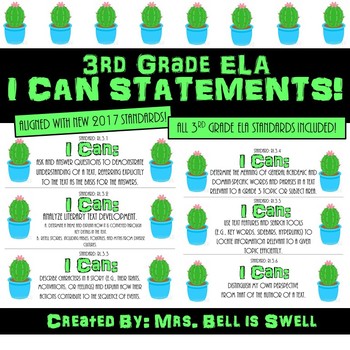3rd Grade ELA "I Can" Statements (Cactus Theme)
Mrs Bell is Swell
80 Followers
Grade Levels
3rd
Subjects
Resource Type
Standards
CCSSRL.3.1
CCSSRL.3.2
CCSSRL.3.3
CCSSRL.3.4
CCSSRL.3.5
Formats Included
- PDF
Pages
32 pages
Mrs Bell is Swell
80 Followers
Description
Thank you so much for your download! I LOVE these I CAN STATEMENTS because they are aligned with the learning standards! They keep me on track and help me to ensure I am hitting every standard! Every standard is included:
Literacy Standards
Informational Standards
Foundational Standards
Writing Standards
Speaking and Listening Standards
Language Standards
They’re also great for the kiddos to see the learning targets posted in the classroom! Some of the lengthy standards include extra cards to go along with the standard. For example, STANDARD: PHONICS AND WORD RECOGNITION RF.3.3, includes additional (a-d) parts to the standard. Each letter has it’s own card, to be attached to the big standard. This is also great if you want to teach one part of the standard at a time! I hope these work for you and your students! Let me know if there is anyway I can improve this project! For more I CAN STATEMENTS like this one, check out my TPT store (Mrs. Bell is Swell). Also, be sure to check out my Instagram account (Mrs. Bell is Swell), where I post all of my NEW and UPCOMING resources!
ENJOY!
Literacy Standards
Informational Standards
Foundational Standards
Writing Standards
Speaking and Listening Standards
Language Standards
They’re also great for the kiddos to see the learning targets posted in the classroom! Some of the lengthy standards include extra cards to go along with the standard. For example, STANDARD: PHONICS AND WORD RECOGNITION RF.3.3, includes additional (a-d) parts to the standard. Each letter has it’s own card, to be attached to the big standard. This is also great if you want to teach one part of the standard at a time! I hope these work for you and your students! Let me know if there is anyway I can improve this project! For more I CAN STATEMENTS like this one, check out my TPT store (Mrs. Bell is Swell). Also, be sure to check out my Instagram account (Mrs. Bell is Swell), where I post all of my NEW and UPCOMING resources!
ENJOY!
Total Pages
32 pages
Answer Key
Does not apply
Teaching Duration
Lifelong tool
Last updated Jun 8th, 2018
Report this resource to TPT
Reported resources will be reviewed by our team. Report this resource to let us know if this resource violates TPT’s content guidelines.
Standards
to see state-specific standards (only available in the US).
CCSSRL.3.1
Ask and answer questions to demonstrate understanding of a text, referring explicitly to the text as the basis for the answers.
CCSSRL.3.2
Recount stories, including fables, folktales, and myths from diverse cultures; determine the central message, lesson, or moral and explain how it is conveyed through key details in the text.
CCSSRL.3.3
Describe characters in a story (e.g., their traits, motivations, or feelings) and explain how their actions contribute to the sequence of events.
CCSSRL.3.4
Determine the meaning of words and phrases as they are used in a text, distinguishing literal from nonliteral language.
CCSSRL.3.5
Refer to parts of stories, dramas, and poems when writing or speaking about a text, using terms such as chapter, scene, and stanza; describe how each successive part builds on earlier sections.





